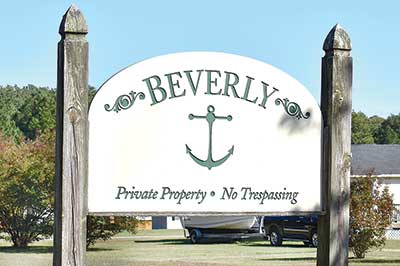
First in a two-part series on Beverly Beach Subdivision
by Larry Chowning –
The year of 1946 was just about 80 years since the Civil War ended and Middlesex County Blacks had been delivered from the bondage of slavery with the ending of the war.
In 1946, the first Black-owned waterfront subdivision was created by Dr. M.E. Toney Sr. of Middlesex and Dr. George W. White of Norfolk.
After slavery, the creation of Black churches and ownership of land were primary goals of progressive Blacks. Even before slavery ended in Middlesex, free Blacks owned land and those families had a social and economic advantage over Black families who gained their freedom right after the war. This advantage often went on for generations.
Right after the war, some former white slave owners gave or sold land on the outskirts of their farms to former slaves in an effort to give them a home and to keep them working their land.
Town Bridge Road near Urbanna on land near Glebe and Hewick plantations; on Stormont Road on land near Wood Farm and Deerchase; on land near Nesting Farm in Jamaica, there are, to this day, pockets of Blacks living in the first Black subdivisions in the county, created primarily to keep Blacks from leaving and to keep them segregated from whites.
The year 1946 was a game-changing year in Middlesex when the first Black-owned surveyed waterfront Beverly Beach subdivision in Middlesex County was created.
The first white-owned waterfront subdivisions were mostly owned by farmers who started selling off 50-foot wide lots side-by-side on the Rappahannock River to city folk. The sale of those properties for $500 or so seemed profitable then, but the reality of it was that they were selling off generational assets — waterfront property — for peanuts.
Right after World War II, Middlesex County’s awareness that waterfront property could be a valued possession was becoming more and more evident. Most of the valued waterfront property in the county, as it is today, was owned by whites.
John and Irene Korbach
John and Irene Korbach were Germans who had moved to Middlesex around the World War II era. They owned 66 acres of prime waterfront property on Route 3 near Topping and throughout the war had been “harassed” by locals over their German ancestry.
The Korbachs approached Dr. M.E. Toney Sr., a black physician in the county, about purchasing the Beverly Beach property. Toney’s grandson Wayne Toney recalls that “the Korbachs asked my grandfather if he wanted to buy it. They did not want to sell to anybody white.
“My grandfather owned another farm and was not that interested in waterfront property,” said Toney. “At first, he told them that he needed to think about it.
“While considering the purchase, he asked my mother, his daughter-in-law, what she thought,” he said. “When my mother saw the property and that view of the Rapphannock River reaching out into Chesapeake Bay, she fell in love with it and pleaded with Big Daddy, as we called him, to buy the land.
“Big Daddy called his friend Dr. George W. White (a dentist) in Norfolk about going in with him on purchasing the property. White, an African-American, agreed to go in with Toney on the purchase. They had Klondike Willie Stiff survey the land. They subdivided the property and created marketable size lots and sold specifically to Blacks. The subdivision was named Beverly Beach after Dr. Toney’s daughter-in-law, Beverly Christian Toney, who encouraged the purchase of the property.
Memories of Beverly Beach
Wayne Toney recalls some very primitive living conditions in the early days. “I remember having to come down here every weekend” (from Richmond), he said. “I hated it because our summer home was a two-room shack that we called the castle. It had no running water, no beds. I slept on a cot. There was no air-conditioning, and no stove. We cooked on a hot plate and we had a refrigerator.
“My grandfather’s cottage was state of the art in the early 1960s. He had running water, a fully enclosed porch around the entire house,” he said. “There was a shower too. My mother and grandmother did not get along so we only went into the house to take showers and wash up.
“The best thing about those times was the frozen custard at the Saluda Drive-in and Rich’s Supermarket at Locust Hill,” he recalled. “Rich’s had the best selection of AMT, Revell-Monogram model cars. My mother, to keep me from complaining about coming to the country, would promise to buy me a model car on each trip. I think Rich’s helped me develop my love of drag racing.”
“I learned to drive at Beverly Beach at the age of thirteen and experienced all the different fishing holes. Butlers Hole was our favorite spot to fish and most times there were 50 to 60 boats out there fishing. Many times, we’d pull up croakers two at a time and have a boatload before noon,” he said.
“In the early years, most of the homes were owned by relatives and friends and they were all Black,” said Wayne. “There were brothers, sisters, cousins and colleagues who worked with my grandfather and parents. It was all about family playing Chinese checkers, Crazy Eights (card game), War card games, and popping popcorn with old oil left from the weekend before. Even though I complained about coming to the river, I look back on it as an opportunity most Blacks did not have then. That changed in the 1980s.
(The second part of the series will speak to those changes and how they have impacted Beverly Beach and Middlesex County.)



